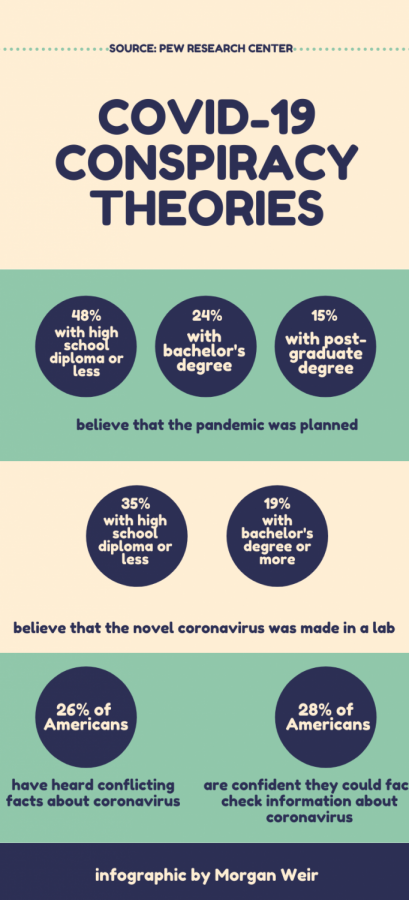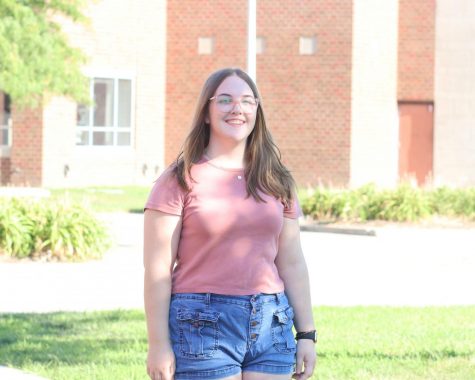Coronavirus conspiracies
Pandemic theories move to mainstream
The current wave of conspiracy theories has quickly spread to mainstream audiences. Many factors influence who is most likely to believe them, including political affiliation and education level.
September 21, 2020
In the middle of incredibly turbulent times, people have been looking for something to hold on to. As a global pandemic, presidential election and nationwide protests all converge, many are choosing to make up stories about government conspiracies rather than learn the facts. Because of these uncertain times, the recent wave of conspiracy theories has spread to the mainstream at higher levels than in previous waves.
Some conspiracy theorists have taken it to extremes and claimed that COVID-19 does not exist at all or that it is being highly over-exaggerated by the government and the media. A survey from The Economist and YouGov in March found that 13% of Americans believe that the coronavirus is a hoax, while 44% believe it is being exaggerated for political reasons. This theory is ridiculous. It is completely unfounded and ignorant. The idea that doctors, nurses, politicians, patients, researchers, scientists and everyone else involved have all collaborated to fabricate a global pandemic is a bit of a stretch, to say the least. As for the claim that it is being exaggerated, there have been 454 reported deaths from COVID-19 in Nebraska alone as of September 16. There have been hundreds of thousands of deaths globally. Medical experts, including Dr. Anthony Fauci, the director of the National Institute of Allergy and Infectious Disease, have said that this number is more likely an undercount than an overcount.
Another popular coronavirus conspiracy theory is that Bill Gates is trying to profit off the vaccines and that he wants to use vaccines to plant microchips into people. The media analysis company Zignal Labs found that this is the most widespread of all the coronavirus falsehoods they track. By April, it peaked at 18,000 mentions a day on social media. People have every right to be skeptical of a vaccine, especially as governments and pharmaceutical companies rush to be the first to get one out. We should be having conversations about whether this vaccine is being pushed for political reasons or whether it’s being rushed without proper, extensive testing. However, to hijack that conversation with absurd claims that have no evidence is unfair and irresponsible. The more misinformation and fear spreads about vaccines, the harder it will be to distribute it and reach herd immunity once a vaccine is approved.
The idea that 5G causes health and privacy issues is another theory, one that existed before coronavirus, but the pandemic has helped it reach mainstream audiences. Conspiracy theorists point to 5G towers installed in Wuhan in 2019 before the outbreak of coronavirus. Some say that these towers cause radiation that triggers the virus while others say it was invented by the government as a cover-up to implement 5G globally and take away citizens’ privacy. In fact, a June survey from Pew Research Center found that 25% of people believe there is some truth to the theory that the government manufactured or planned the pandemic. As is the case with many of these conspiracy theories, people point to untrue or misguided “evidence” to back up their claim. One such example is the claim that the government patented a vaccine for the coronavirus in 2019, before the novel coronavirus had spread. That patent, however, was not for SARS-CoV-2, the form of coronavirus causing the current pandemic. It was “related to a form of coronavirus that could potentially be used as a vaccine to prevent diseases in birds and other animals” as the Poynter Institute noted in their fact check. This theory has had many harmful real-world consequences, including vandalism and arson attacks on cell towers in Europe.
An extension of the theory that the government planned the pandemic is the theory that this is a step in the ladder to the government taking away all of our rights, specifically when it comes to masks and other restrictions. Anti-masks rallies were held in cities worldwide all summer long as the death toll for COVID-19 continued to rise. Many of these protests were held in a country that has not set many federal restrictions and in states that have left much of the policy-making for public safety in the hands of individual cities, districts and businesses. People are claiming the government is trying to implement martial law in places where barely any restrictions are in place. This theory in particular highlights the fact that conspiracy theories have an agenda, and that agenda is often rooted in ignorance, hatred and selfishness rather than in facts. The same people who protested on the steps of capitals with guns when they couldn’t get a haircut hid in their houses and whined on social media as people marched in the streets and demanded Black lives be protected. For example, a network of Facebook groups with over one million members helped orchestrate the protests against stay-at-home orders in April. By June, they had done a one-eighty as Black Lives Matter protests spread across the country. One group changed their name from “Reopen California” to “California Patriots Pro Law and Order.”
Often, the subscribers of these theories claim that they have their eyes opened to things that average people don’t see. However, they are blind to the fact that many of these conspiracy theories originate from QAnon, a far-right conspiracy theory which has been deemed a potential terror threat by the FBI. The way these theories are being spread is incredibly calculated, and it’s a blatant power ploy in the middle of an election.
There is nothing wrong with questioning or dissenting from popular opinion. However, going about it in a way that is misinformed and cult-like makes a mockery of it. It’s easy to grab on to the first thing we see on social media that explains the confusing world we live in, and at a time when it’s so hard to find what the truth is, people can’t necessarily be blamed for being unsure. However, there is a clear line between analyzing things deeply and spreading misinformation. As the growing anti-vaccination movement, damaged cell towers and rising COVID-19 deaths prove, these conspiracy theories are not harmless.







